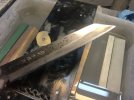The Nubatama series of stones is a bit complex and one should really seek advice before making any decisions. If you are looking at the Black 180 grit Bamboo stone I would advise against it, it's a very nice stone that has great grinding feel but it favors German stainless and softer steels in general, plus it tends to wear quickly (though thats kinda common with coarse stones).
The 150 bamboo is kinda the go-to stone in the Nubatama line, it's fast, slower wearing than most, and less muddy. The muddy nature of coarse japanese Waterstones is fine if you are sharpening traditional Japanese blades but for most standard bevels the thick mud rides up the side and washes out the shoulder. It's much better with the 150 Bamboo but can still occur.
In the end, stones below 300 grit are less practical than diamond plates for general sharpening. Now, if you are sharpening knives like this single bevel below then I can understand the need but for everything else the cheap 120-150 grit plates followed by a 300-500 grit waterstone is a much better progression of stones.
View attachment 545811
As Brian said, I would recommend a set of stones in most cases. It's not exactly easy to mix stones and end up with something that works. Some combos I would recommend on the coarse end prior to 1k,
Atoma 140, 400
Atoma 140/DMT XXC, Shapton Pro 320
Atoma140/DMT XXC, Shapton Glass 500
Atoma 140/DMT XXC, Nubatama Ume 320
Atoma 140/ DMT XXC, Naniwa Professional 400
I recommend quality Diamond plates for use as lapping tools - I recommend cheap plates for bevel setting duity because you tend to wear out the plates using them for double duity. At least I do.

